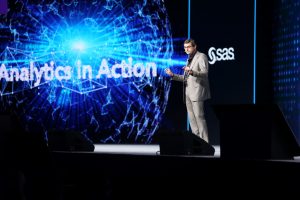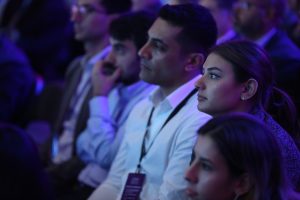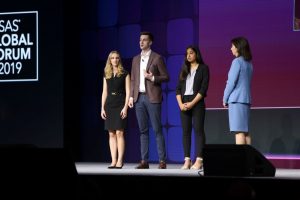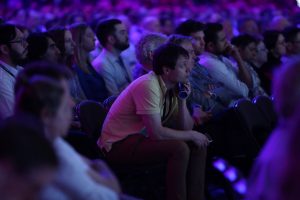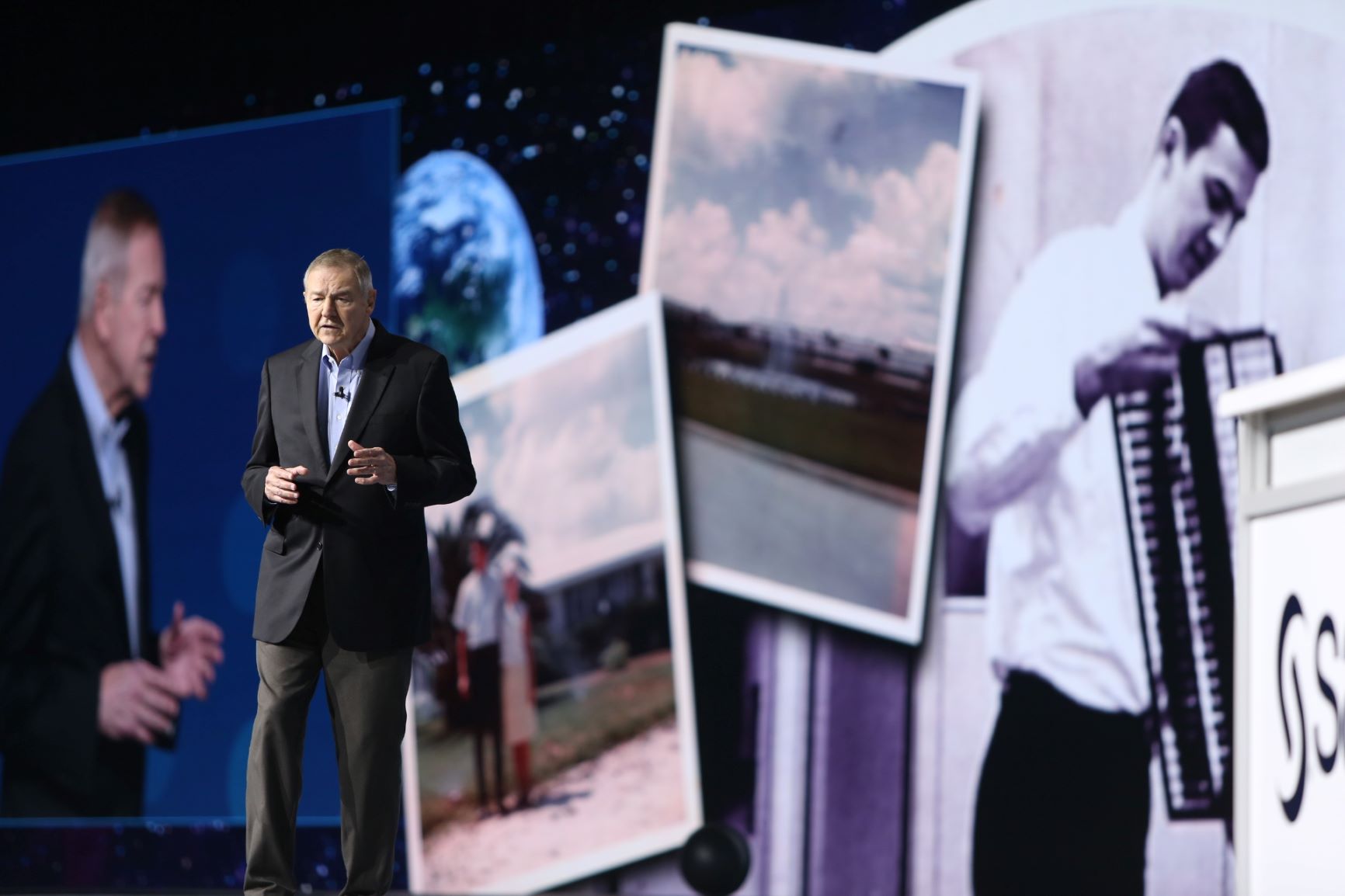
A record-breaking crowd of more than 5,500 analytics enthusiasts received a Texas-sized welcome from CEO Jim Goodnight as he opened SAS® Global Forum 2019.
This is the fourth time the forum has been held in Dallas, and this year, the evening started with a look back at one of the greatest moments for mankind – when two Apollo 11 astronauts walked on the moon 50 years ago.
Goodnight shared that his connection to that history-making moment went beyond just watching it on TV. As a software developer for the Apollo program, Goodnight was part of the team that brought space travel to the world.
“We remember names like Neil Armstrong, but did you know that it took 400,000 data scientists, technicians, mathematicians and engineers to turn that idea into reality?” asked Goodnight. “They were the ones creating new materials, technology and mathematical models to land man on the moon and return him back to Earth.”
Putting a man on the moon forever shifted our mindset on what was possible with technology, but, 50 years later, there are still parallels between our world today and our world then. Powerful technologies are at our disposal, but challenges remain. How do we make sense of all the data we have? How can we use that data to solve the world’s biggest challenges?
That’s where SAS steps in, putting analytics into action in real, tangible ways. SAS® Analytics help combat climate change, eradicate poverty and automate mundane tasks to allow people, organizations and governments more room for strategy and creativity.
“We are providing the platform that allows everyone to take part in analytics – one that is open to every tool in your analytics environment,” said Goodnight. “One platform that can support every phase of your analytics journey, from an inception of an idea to enterprise deployment.”
Visioning future possibilities
That platform supports a wealth of new and trusted technologies – including computer vision. To demonstrate, in real-time, SAS' ability to identify objects from streaming video, Goodnight welcomed volunteers from the audience to participate in a facial recognition demonstration. This intriguing technology is a computational challenge that requires massive compute power and could be instrumental in adding an extra layer of identification security at ATMs or making it easier to scan into your workplace without a badge. But, the software doesn’t just recognize faces; it also recognizes objects and animals.
#TinyYolo v2 at work during #sasgf, identifying these volunteers during Opening Session. #computervision #AI pic.twitter.com/35xxRLeH2l
— Chris Hemedinger (@cjdinger) April 29, 2019
“There are some interesting applications of computer vision when you combine it with predictive analytics. It can detect abnormalities in images to help for cancer screenings,” said Goodnight. “We are working with a jet engine manufacturer to find defects invisible to the human eye using computer vision.”
Making our vision a reality
“Our data-driven world is hungry for analytics,” said SAS Executive Vice President, Chief Operating Officer and Chief Technology Officer Oliver Schabenberger, who shared the real-world ways SAS is putting analytics into action. “We are not adding to the hype or buzz about artificial intelligence or digital transformation. We are making it real.”
In a world shifting from hardware to software to intelligence and from physical assets to bits and bytes, organizations are looking to partner with organizations like SAS to chart their digital transformation journeys. Whether they are concerned about the disruption, how to meet customer expectations, how to find the right talent or how to pivot business processes and systems, Schabenberger assuaged these concerns by reminding forum attendees that they aren’t as far behind as they might think.
“The goal is not to compete with Google, Amazon, Facebook or other giant companies,” said Schabenberger. “The goal is to derive value for your organization – in your industry sector.”
"We are not adding to the hype or buzz about artificial intelligence or digital transformation. We are going to make it real." - @oschabenberger #SASGF pic.twitter.com/kjw2jk7oIX
— SAS Software (@SASsoftware) April 29, 2019
Analytics for everyone
Attendees always value the insights and perspectives of SAS leadership, but there is something special about hearing the stories from organizations that are transforming our world through practical, fit-for-purpose applications of analytics.
Citi took the stage to share how they are collaborating with SAS and working with EY to improve risk and compliance processes. And, Experian shared how SAS® Viya® is driving their new resilient, in-memory analytics platform in the cloud that truly scales. With it, they have the full spectrum of analytics, including advanced techniques like AI, machine learning and deep learning.
Melissa Sokolosky, founder of IndiOmics, joined SAS’ Diana Shaw to demonstrate how analytics helps the biotech company understand how the human body responds to common chemical exposures in an effort to help people safeguard themselves with simple lifestyle changes. Schabenberger was a good sport in volunteering to participate in the analysis, which fortunately revealed he had a below-detection level of BPA in his system – a testament to his limited use of plastic drinking containers and cookware.
And, finally, North Carolina’s New Hanover County pulled on the heartstrings of the entire audience, sharing how SAS® technology is helping them save the most vulnerable victims of the opioid epidemic: children.
“To protect children, we need greater access to data. Without it, our social workers are working in the blind,” said a New Hanover County representative. “Our partnership with SAS provides alerts if the risk level of children in our county increases. Analytics is allowing us to provide valuable insights that protect children and save lives.”
Analytics isn't just numbers on paper...it's people. #data4good #sasgf https://t.co/RG2IQlpcmR
— Brandy Mann (@BrandyEMann) April 29, 2019
Breaking down barriers, bridging the skills gap
Whether it’s closing the analytics skills gap, encouraging interest in STEM or improving reading proficiency, SAS has always been passionate about creating opportunities for all through education.
SAS Global Forum Chair MaryAnne DePesquo introduced three amazing young minds who are impressive examples of analytics in action.
- Richa Sehgal, a high school student who has started her career in life sciences, uses SAS to identify cancerous tumors, with hopes that her research analysis can be used in the future to increase cancer survival rates.
- Poland’s Piotr Małaszek, began his career in the SAS Young Talents Academy and now works in the financial industry. He received the SAS Global Forum Student Ambassador Award and started volunteering at SAS Global Forum conferences. These experiences led him to his current work with real-time fraud detection.
- Jenna Cody received a New SAS Professional Award this year. She is a biostatician who strives to study brain diseases and develop treatments that improve a patient’s quality of life. By analyzing volumes of data in SAS, she can quickly identify safety concerns throughout the life cycle of the drug development and trial process.
Senior Software Developer Jennifer Sabourin then shared some of SAS’ latest efforts to close the skills gap by using GatherIQ and CodeSnaps in K-12 schools. Attendees were introduced to one of many Dallas students who got to experience CodeSnaps first hand through a SAS-led project at the Boys & Girls Club of Greater Dallas.
Love the work we’re doing with Boys & Girls Clubs to get kids excited about coding. This brave, little girl got on stage in front of a HUGE crowd. #SASGF pic.twitter.com/Vua3MmHqX2
— Trent Smith (@TrentSmithNC) April 29, 2019
The new version of GatherIQ equips students with valuable skills necessary to solve the world’s problems, both big and small. Through problem-based learning centered on the United Nation’s Global Goals, students are challenged to think with the world’s needs in mind as they not only collect and analyze data but also disseminate their results in meaningful ways.
Download GatherIQ now to explore our new app for yourself. Throughout SAS® Global Forum, you can move through the app to unlock micro-donation coins that will be added to SAS’ $5,000 donation to the Boys & Girls Clubs of Greater Dallas.
